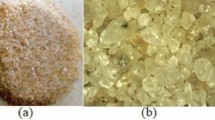Abstract
Su-Xi-Chang area is one of the typical regions in China which suffers from severe land subsidence. Various tools of field monitoring were integrated to study the characteristics and mechanisms of land subsidence in this region. The occurrence and the development of the land subsidence in this region are strongly related to the groundwater pumping both in time and space. The main consolidation layers are the soft mud layers; however, the compressibility of the confined sandy layers should not be ignored. The second and third confined aquifers contributed more than 30% of total subsidence. Meanwhile, irrecoverable deformations were also observed in the sandy layers. Different sandy layers deform diversely under different stress conditions. Some have the elastic feature. But the soil strata, including both sandy layers and clayey layers, located in the center of the groundwater level depression cone exhibited obvious viscous mechanical behavior which caused the common lag phenomenon. The sand composition (mingled with small clay particles or interbeds) and sand rheology are the two main reasons for the lag phenomena in sandy layers. A series of laboratory tests for modeling the effective stress changes due to groundwater withdrawals, were conducted to investigate the mechanism of the lag phenomenon. Based on the test results, the relationship of stress–strain–time for saturated sands is obtained; and it could be expressed as power functions. The results also showed that the compression of the sandy layers was time dependent, and its deformation could be remarkable. When establishing land subsidence model, the deformation for the similar soil formation could be elastic, visco-elastic and even visco-elastic–plastic, because of the different groundwater level fluctuation experienced.




















Similar content being viewed by others
References
Gambolati G, Freeze RA (1973) Mathematical simulation of the subsidence of Venice: 1. Theory. Water Resour Res 9(3):721–733
Gambolati G, Gatto P, Freeze R A (1974) Mathematical simulation of the subsidence of Venice: 2. Results. Water Resour Res 10(3):563–577
Gu XY, Ran QQ (2000) A 3-D coupled model with consideration of rheological properties. Land subsidence. In: Proceedings of the 6th international symposium on land subsidence, vol 11, pp 355–365
Helm DC (1975) One-dimensional simulation of aquifer system compaction near Pixley, California, (1) constant parameters. Water Resour Res 11:198–212
Helm DC (1976) One-dimensional simulation of aquifer system compaction near Pixley, California, (2) stress-dependent parameters. Water Resour Res 12:121–130
Hu RL, Wang SJ, Lee CF, Li ML (2002) Characteristics and trends of land subsidence in Tanggu, Tianjin, China. Bull Eng Geol Environ 61(3):213–225
Lambe TW, Whitman RV (1979) Soil mechanics. SI version. Wiley, New York
Leake SA (1990) Interbed storage changes and compaction in models of regional groundwater flow. Water Resour Res 26(9):1939–1950
LEHGGS (Laboratory of Engineering and Hydrological Geology and Geophysical Survey, Liege university, Belgium, Institute of geological survey of Belgium), GCSER (Geological center of Shanghai Economic Region) (1989) Study on the quaternary geology, hydrogeology, engineering geology and mathematical model of land subsidence of Yangtze Delta of Shanghai (in Chinese)
Liu CH, Pan YW, Liao JJ, Huang CT, Shoung OY (2004) Characterization of land subsidence in the Choshui River Alluvial Fan, Taiwan. Environ Geol 45(8):1154–1166
Men FL (1999a) Preliminary investigations on rheological properties of clay and ground settlement in Shanghai City (I) (in Chinese). J Nat Disasters 8(3):117–126
Men FL (1999b) Preliminary investigations on rheological properties of clay and ground settlement in Shanghai City (II) (in Chinese). J Nat Disasters 8(4):123–132
Pratt WE, Johnson DW (1926) Local subsidence of the Goose Creek field. J Geol 34(7):577
Prisco D, Imposimato S, Vardoulakis I (2000) Mechanical modeling of drained creep triaxial tests on loose sand. Geotechnique 50(1):73–82
Poland JF, Davis GH (1969) Land subsidence due to withdrawal of fluids. In: Reviews in engineering geology, vol II. Geological Society of America, p 187
Poul VL, Liu CT (1998) Experimental study of drained creep behavior of sand. J Eng Mech 124(8):912–920
Sneed M, Galloway DL (2000) Aquifer-system compaction and land subsidence: measurements, analyses, and simulations-the Holly Site, Edwards Air Force Base, Antelope Valley, California. US Geological Survey Water-Resources Investigations Report 00–4015, pp 65
Singh A, Mitchell JK (1968) General stress–strain–time function for soils. J Soil Mech Found Div ASCE 194(1):21–46
Terzaghi K (1925) Erdbaumechanik auf bodenphysikalisher Grundlage. Deuticke, Wien
Vyalov SS (1986) Rheological fundamentals of soil mechanics. Translated by Sapunov OK. Elsevier, Amsterdam
USGS (1999) Land subsidence in the United States. In: Galloway D, Jones D, Ingebritsen SE (eds) Circular 1182. ASCE, New York, pp 177
Yu J, Wu JQ, Wang XM, Yu Q (2004) Research on the correlative prediction model with a regional decomposition base of the land subsidence in the Suzhou-Wuxi-Changzhou area (in Chinese). Hydrogeol Eng Geol 4:92–95
Acknowledgments
The author would like to express appreciation to the two anonymous reviewers for their valuable comments and suggestions. This paper is financially supported by the National Nature Science Foundation of China grants 40335045 and 40402023.
Author information
Authors and Affiliations
Corresponding author
Rights and permissions
About this article
Cite this article
Shi, XQ., Xue, YQ., Ye, SJ. et al. Characterization of land subsidence induced by groundwater withdrawals in Su-Xi-Chang area, China. Environ Geol 52, 27–40 (2007). https://doi.org/10.1007/s00254-006-0446-3
Received:
Accepted:
Published:
Issue Date:
DOI: https://doi.org/10.1007/s00254-006-0446-3




